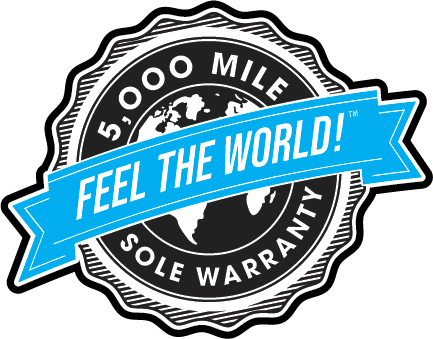University of Colorado Barefoot Running Study
The media is having an anti-barefoot running field day thanks to a study published by some people right up the street from me at the University of Colorado (BTW, I’ve been living in Boulder for 19 years and nobody has been able to explain why they call the university CU instead of UC.).
Each of the dozens of articles about the study has a distinct flavor of elementary school playground taunting, “Nah, nah, nah, nah, boo, boo… barefoot running isn’t good for you!”
I mean, check out some of the headlines:
Debunking the Barefoot Running Myth – Sydney Morning Herald (barefoot running isn’t like bigfoot!)
Here’s Proof Barefoot Isn’t Better — Running Times (Ha! So there!)
It almost feels like the press is enjoying creating a backlash to all the “pro” barefoot articles of the last two years, even though in every barefoot article I’ve read the media insists on publishing “both sides of the story,” and includes some doctor who’s never run a meter in bare feet and wouldn’t know decent barefoot running form if it ran him over, claiming that running without shoes will hurt you, bring shame on your family, and accelerate the coming apocalypse.
So, let’s take a deep belly breath or two and have a chat about the study. In fact, let’s start by talking about studies, in general:
Designing a biomechanics study is not easy. Aside from deciding exactly what you want to explore and the best design of the study itself (how you can test it), finding enough of the right kind of participants is often tricky, if not impossible.
It’s even more difficult to design a study that isn’t artificial in some way. That is, it’s showing effects in a lab that may not be relevant in the real world.
And, even more, many studies, while interesting, may not be relevant to the broader population. (Whenever someone quotes a study, or even just the habits, of elite marathoners, I respond “Unless you’re 5’5” and weigh 105 pounds and run at 13 miles per hour for two hours… WHO CARES what those guys do?)
Finally, the way the media picks up a study — this one or any of the previous barefoot studies — often adds some spin that isn’t in the actual study.
All of the issues I just raised are relevant as we take a gander at the CU study. BTW, if you want to see a lively and cogent critical look at the study, you can’t go wrong with reading the comments on the New York Times article about it. Frankly, this post probably won’t be as lucid as some of the comments there.
Okay, let’s jump into it… The gist of the study:
“In the study, 12 subjects with substantial barefoot running experience ran at 7.5 MPH with a mid-foot strike pattern on a motorized treadmill, both barefoot and in lightweight cushioned shoes (~150 g/shoe, 5.4 oz). In additional trials, they attached small lead strips to each foot/shoe (~150, ~300, ~450 g). For each condition, they measured the subjects’ rates of oxygen consumption and carbon dioxide production as an index of metabolic cost.”
And the results:
a) For every 100g (3.5oz) (the average weight of a deck of playing cards) added per foot, energy cost increases by approximately 1% whether running barefoot or shod.
b) Running barefoot and in lightweight shoes do not significantly differ in energy cost.
c) When controlling for shoe/foot mass, running in lightweight shoes requires ~3-4% less energy than running barefoot.”
Now, let the fun begin. Can you find the “confounds” (the factors in the study that might affect the results, or the interpretation of the results)?
I’ll start. Let me know if you find more.
1) How did they determine that the 12 subjects had “substantial barefoot experience?” Well, the study says, “8 km/week barefoot or in minimal running footwear (e.g. Vibram Five Fingers) for at least 3 months out of the last year.”
Does 3 months out of the last 12 really equal “substantial?” I’ve been barefoot for 3 years, and I’m STILL improving my form.
And if that three months was wearing VFFs or minimalist shoes, that counts as “barefoot experience” Uh…
As I’ve commented, and as the American Council on Exercise showed, and as Pete Larsen from www.runblogger.com captured on video: VFFs are not the same as barefoot.
Now the researchers did verify that the subjects all ran with a “midfoot or forefoot” landing. I know that Lee Saxby, the spokesman and coach from Vivobarefoot would have an issue with that. He doesn’t think midfoot is proper barefoot form (there’s some debate about that, but it’s besides the point at the moment).
2) They ran on a treadmill. Look, I get that testing runners on an actual track is hard and expensive, but running on a treadmill is not the same as running on the ground, end of story. It may give some useful data, but if it walks like a duck and quacks like a duck, but the duck is on a treadmill… hmmm, that analogy isn’t quite working, but you know what I mean.
I did some high-speed video analysis of my running at the Monfort Human Performance Lab. I hit 21 mph on that treadmill. I can tell you that when I’m on a treadmill, my stride is different than on the track. I overstride so I can “catch” the treadmill belt, for example.
3) To simulate a running shoe’s weight, the researchers put lead weights on the top surface of the runners’ feet. Do you think some small weights pressing down on your foot is different than having that same amount of weight distributed evenly, and mostly under your foot, thanks to the design of the shoe? I do. Does that matter? Could be. Is there a way to check… not easily.
4) The runners were at 7.5 miles per hour. That’s slow for an elite runner — about 200 meters in a minute, a quarter mile in 2 minutes, a mile in 8 minutes — but fast for most casual runners. This raises a few questions:
a) How was that pace compared to the runners’ usual training pace?
b) Does speed make a difference?
c) What about turnover, or cadence? Were those controlled and the same when the runners were barefoot vs. shod?
Got me. But, suffice it to say, we’re seeing the artificial quality of the study.
5) Oh, this wasn’t mentioned above, but I’ll give it to you now: the runners were wearing yoga socks. ““For the duration of the experiment, subjects wore very thin, slip-resistant yoga socks for safety and hygienic purposes.”
Hygienic purposes? Uh, some 409 and a paper towel would handle any “hygiene issues.” And “safety”? If you read the study, one aspect of “safety” is “avoiding blisters.”
Boy, where to start on that one? We know that socks does not equal barefoot, and we also know that if you get blisters when you run barefoot, you’re doing something wrong. So, this brings us back to number 1 — how experienced were these runners really?
6) The study measured oxygen consumption and carbon dioxide production. Okay, that’s a fine way to measure efficiency, based on the idea that using less oxygen and producing less CO2 means you’re using less effort, and that equals being more efficient.
But here’s a question: So what?
For one: does using less energy equate to faster times? It seems like it might, but that’s not a given.
Does the amount of extra energy being used by *some* of the barefoot runners have any relevance to the average runner? Someone for whom 7.5 mph is too fast… or even too slow?
7) Oh, here’s a favorite. The runners in the study wore an ultra-lighweight racing flat. Most runners wouldn’t wear those. And most runners with no barefoot experience wouldn’t find those any friendlier than being shoe-free.
8) One other thing: A hallmark of the scientific method is reproducibility. Just because one lab gets a result, that doesn’t mean the question is resolved. When a study is reproduced in independent labs and the same (or very similar) result is obtained… then you know you’ve got something.
What if the study is correct, though? What if barefoot running is less efficient than shod running?
The only answer I can come up with is: Who cares?
I don’t mean that it’s not important to know. I mean, literally, who should care?
If you never race, you’ll never notice any difference in efficiency (assuming, again that “decreased efficiency” = slower times).
Besides, there are MANY other reasons to run with bare feet than the idea that it’s more efficient… many that have barely been touched on (Dr. Michael Merzenich and I have had some interesting chats about how being barefoot could help the elderly in various ways). Personally, I didn’t make the switch for efficiency’s sake. In fact, for me, as a sprinter, I know I’m more effective in spikes than barefoot. I switched because it helped me correct some form problems, eliminated injuries I was getting, turned running from a chore into an enthralling discovery, and, more importantly… WAS FUN.
Don’t get me wrong, I’m thrilled that my Boulder neighbors are researching barefoot running. And while this is the first published study, I know they have more coming and I’m looking forward to those.
And I’m certainly not blaming them for how the media is handling the story.
My only interest is the continued exploration, conversation, and understanding of efficient movement, running for speed and/or distance, and the ways of teaching and exploring barefoot running (and walking and hiking).
No one study can perfectly address all of the open questions. But the almost combative attitude where everyone wants to jump on some one-sided “We’re better!” bandwagon certainly doesn’t help.
Suffice it to say, this study is not the death knell of barefoot running that many media outlets are portraying it to be (because, you know, controversy is more important than truth if you’re trying to sell papers).
Now, if you’ll pardon me, I have to burn off some of my frustration by putting on some yoga socks and minimalist shoes and going for a barefoot run.
p.s. (added on 4/4/2012):
I just realized that the conclusion of the study was WAY off base!
Here’s why
The researchers think that the improved efficiency of the shoes came from the PADDING absorbing some of the stress that the muscles have to handle when you’re barefoot.
In other words, the ENTIRE efficiency effect could be ALL about the padding and have nothing to do with weight. The weight issue would only be valid if they tested multiple shoes of the same weight with different types of padded outsoles and got the same results.
The content of this post does not constitute and is not intended to be a substitute for professional medical advice, diagnosis or treatment. Always seek the advice of a physician or other qualified health provider with any questions or concerns you may have about your health or a medical condition.



